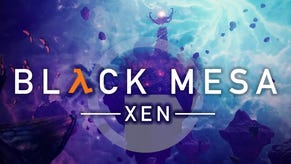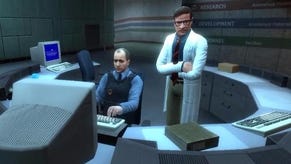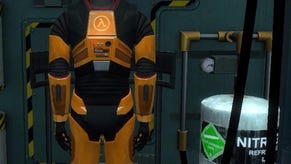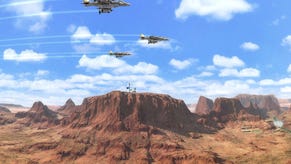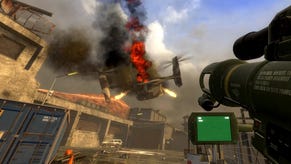Black Mesa review - a masterful remake that improves upon a classic
Xensational
Typical, isn't it? You wait half your life for a new Half-Life game, then two come along at once...
All eyes may be swivelled in the direction of Half-Life: Alyx landing like a gravity-propelled toilet later this month. Yet while everyone's eagerly setting up their VR headsets in preparation, another little chapter of gaming history has just written its final page. Black Mesa, the long-in development remake of Half-Life, is done. Dusted. Finito.
"But wait!" I hear you cry. "Is Black Mesa really a Half-Life game? Can a remake by a bunch of online enthusiasts that's taken fourteen years to finish possibly live up to one of the most influential games ever made?" Well let me tell you, Black Mesa is one Half-Life-ass game. As remakes go, it's about as good as you could hope for. Black Mesa doesn't just make Half-Life better-looking. It makes Half-Life better.
Many of you may already know this. At least, in part. The Black Mesa bit of Black Mesa has been available to play since 2012, while the whole game made its transition from amateur mod project to paid-for Steam Early Access title back in 2015. For a lot of Half-Life fans, this was enough. Many such enthusiast projects never see the light of day, so to get even a partly complete remake of Half-Life felt like a minor miracle. Besides, who cares about Xen? It was always rubbish. Why bother?
Crowbar Collective has their own answer to that, which I'll get to in due course. But it's worth going over the work the studio did converting the Black Mesa facility itself into the Source engine, not least because they've made some further tweaks since 2012.

Black Mesa starts with a ballsy opening gambit, an introductory tram ride that's longer than the one in the original Half-Life. It's odd to think such an iconic moment in FPS history was one of the less-liked aspects of Half-Life on launch. Extending it is a deliberate move on Crowbar Collective's part. It gives you more time to notice the extra details they've added into the introduction.
Black Mesa is more populous than in Valve's original vision, with scientists loitering around the newly introduced railway station, and guards manning security checkpoints that didn't exist in the original. It isn't merely visual stuff that's changed either. The carriage's welcome message now sounds like it's emanating from a speaker, while a whole new soundtrack plays its opening notes out as a 27-year-old MIT graduate begins his worst day at work.
It's a statement by Crowbar Collective. We're not messing around, nor are we slaves to every pixel of Valve's game. This, ultimately, is what defines Black Mesa. The willingness not just to replicate, but to attempt to improve upon the core experience of Half-Life. To refine what works and, crucially, remove what doesn't.
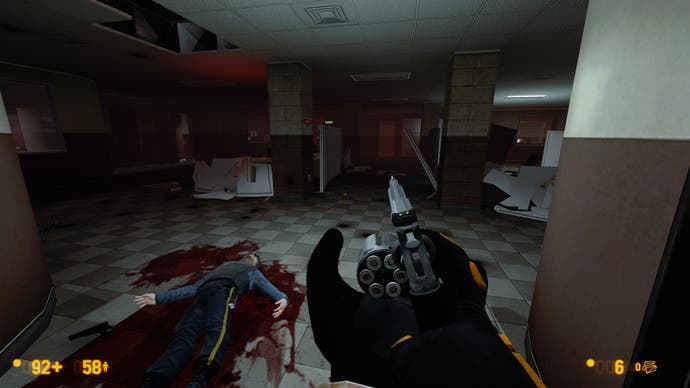
It's surprising how bold Black Mesa is in the latter regard. Certain chapters such as On A Rail have been edited down, cutting out the tedious bits, while other chapters have had elements removed, such as Surface Tension's rogue tentacle monster. Black Mesa also adds completely new elements too, like a greater range of scientists (including female scientists). Meanwhile, there's brand new dialogue and voiceovers intended to add greater context to the plot, and better link the story of Half-Life to its sequel.
All the while, Black Mesa never loses sight of the spirit of the game it's recreating. The opening chapters, Unforeseen Consequences and Office Complex, are pure survival-horror, limiting the player's weapon roster as they dodge leaping headcrabs and evade the claws of zombies. With the arrival of the Marines in We've Got Hostiles, Black Mesa kicks into high gear, offering taut and thrilling combat that Crowbar Collective has been tweaking right up to release, adjusting the Marine's AI so they flank and evade you in the right ways. One big difference between Black Mesa now and in 2012 is it is less punishingly difficult by default. The Marines still feel dangerous, but are no longer robotically accurate in their shooting.
All of this holds up well for what is now an eight-year-old game. But the foundations Black Mesa builds on here were rock-solid to start with, and it's often hard to know whether the brilliance you're experiencing is that of Crowbar Collective, or that of Valve. Black Mesa offers a steadfast response to this with Xen, taking Half-Life's comparatively poor closing levels. (namely Xen, Gonarch's Lair, Interloper, and Nihilanth) and transforming them into what is arguably the best part of the game.
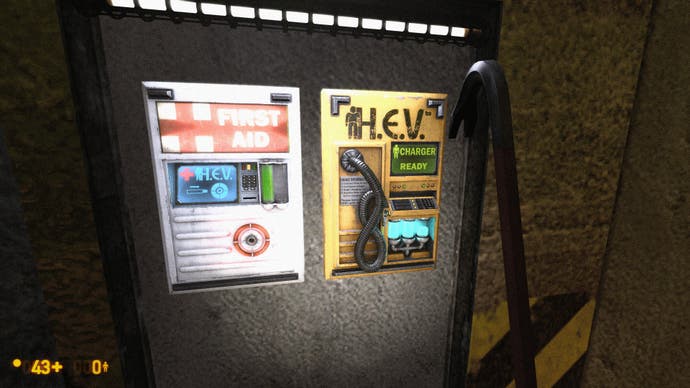
These four levels have been completely redesigned, expanding their limited scope into huge environments complete with new puzzles, encounters and even story elements. Nowhere is this change starker than in the titular Xen level. In Half-Life, Xen was only a few minutes long, comprising a small chain of underwhelming floating islands. By comparison, Black Mesa's Xen offers well over an hour's worth of extra-terrestrial exploration through landscapes that push the Source engine to its limit.
The opening sequence is breath-taking. Gordon stumbles out of the Lambda portal into a vast alien panorama, rocks bobbing in the purplish void ahead of him, partially silhouetted by Xen's ice-blue sunlight. As you approach the precipice of the island you're stood on, a flock of alien birds soars across Gordon's vision as Joel Nielson's rousing soundtrack swells in your ears.
This is but a taste of what Xen has to offer. Crowbar Collective terraform Xen from a brown chain of floating islands into a rich and diverse alien ecosystem. It shows us Houndeyes and Bullsquids in their natural habitats, providing a sense of how Xen functions. My favourite sequence sees Gordon pass through a frontier laboratory established by a previous Lambda exploration team. Not only is it a fantastic piece of additional worldbuilding, it contains a wonderfully devised twist on a classic Half-Life foe.
Xen is primarily an exploration-focussed level, giving you plenty of breathing space to coo at the scenery and puzzle out where you need to traverse to. Crowbar Collective save the fireworks for Gonarch's Lair. Here, the slugfest against Half-Life's infamous testicle-monster has been expanded into a thrilling cat-and-mouse chase filled with twists and surprises. I won't reveal any specifics, but the quality of animation and set-piece design is on par with any modern FPS.
The third chapter, Interloper, begins as promisingly as Gonarch's Lair. Sadly, the extent of Crowbar Collective's ambition does as much harm as good here. The level is overly long, lacking the same environmental variety that sustains the expanded Xen chapter, and repeating several puzzle sequences to the point where they become tedious. While hardly terrible, it is a noticeable step backward compared to the two opening chapters.
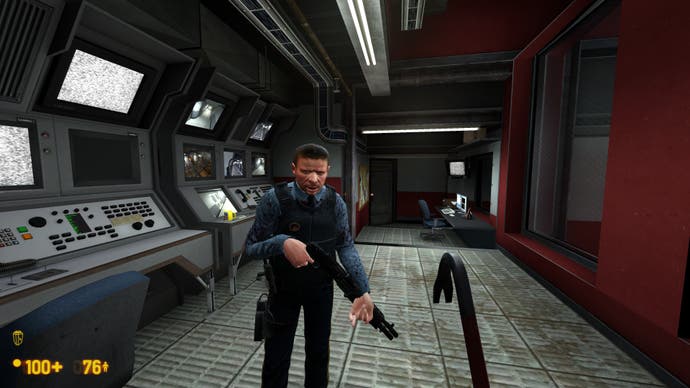
The final confrontation with the Nihilanth is the most straightforward remake of the four chapters, although Crowbar Collective has made some alterations, increasing the spectacle and making it a more direct battle, with no frustrating teleport-based intermissions. It isn't as exhilarating as the encounter with the Gonarch, but it still makes for a satisfying finale.
Black Mesa is a fascinating work. What began as a straightforward engine upgrade for Half-Life has become a game that stands on its own merits, less "Half-Life Remastered" and more "John Carpenter's the Thing." It's an evolution that mirrors that of the people who created it. What formed as a diffuse bunch of enthusiast Half-Life 2 modders has coalesced a remarkably talented and undeniably dedicated studio. I'm curious as to what they will do now. Tempting as it is to say "Opposing Force when?" I'd like to see what they can create on their own terms, unbound from the constraints of nostalgia. Then again, if Valve don't fancy making Half-Life 3, I know a bunch of folk who could do the job.




